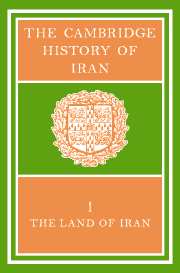Book contents
- Frontmatter
- PART 1 THE LAND
- PART 2 THE PEOPLE
- PART 3 ECONOMIC LIFE
- 15 MINERALS
- 16 INDUSTRIAL ACTIVITIES
- 17 COMMUNICATIONS, TRANSPORT, RETAIL TRADE AND SERVICES
- 18 AGRICULTURE
- 19 WATER USE IN NORTH-EAST IRAN
- 20 PASTORALISM, NOMADISM AND THE SOCIAL ANTHROPOLOGY OF IRAN
- 21 LAND REFORM IN IRAN
- PART 4 CONCLUSION
- Bibliography
- Conversion Tables
- Fig. I. Iran: physiographical.
- Plate Section
- Fig 85. Soil potentiality map of Iran.
- References
16 - INDUSTRIAL ACTIVITIES
from PART 3 - ECONOMIC LIFE
Published online by Cambridge University Press: 28 March 2008
- Frontmatter
- PART 1 THE LAND
- PART 2 THE PEOPLE
- PART 3 ECONOMIC LIFE
- 15 MINERALS
- 16 INDUSTRIAL ACTIVITIES
- 17 COMMUNICATIONS, TRANSPORT, RETAIL TRADE AND SERVICES
- 18 AGRICULTURE
- 19 WATER USE IN NORTH-EAST IRAN
- 20 PASTORALISM, NOMADISM AND THE SOCIAL ANTHROPOLOGY OF IRAN
- 21 LAND REFORM IN IRAN
- PART 4 CONCLUSION
- Bibliography
- Conversion Tables
- Fig. I. Iran: physiographical.
- Plate Section
- Fig 85. Soil potentiality map of Iran.
- References
Summary
Sugar-refining may be regarded as one of mankind's first large-scale industrial activities to employ more than a handful of workers and to use substantial quantities of fuel. Although it originally developed in the Iranian province of Khūzistān in the first centuries A.D., neither it nor any of the other early industrial activities (metal-working, textiles, dyes) survived into the nineteenth century. Even arts and crafts, normally a source of skill for industrial development, had decayed by then and could not be used as a nucleus for industrial growth. For this reason all the factors required for the building up of modern Iranian industries–management, skilled and semi-skilled labour, as well as capital–had to be imported from abroad. All that the country could supply in the first stages of modern industrial development were natural resources, and to this day exploitation of resources, especially petroleum, dominates the Iranian industrial economy.
Only at a later stage did there emerge modern industries such as textiles, which were not based on the exploitation of local resources. These industries began operation between the two world wars and grew rapidly during World War II and thereafter, relying on foreign machinery and instruction; however, most of the capital was provided from within the country. To some extent these newer industries are related to the re-emergence of arts and crafts, especially carpet-making. Based on traditional skills and patterns, and carried out and financed entirely by Iranians, arts and crafts began to reappear at the end of the nineteenth century, when foreigners were starting to take an interest in Iranian resources; and until recently, these activities owed their growth to markets abroad rather than in Iran. The following sections describe the evolution of the geographical distribution of modern industries and arts and crafts together with their effect on the regions and cities of Iran.
Keywords
- Type
- Chapter
- Information
- The Cambridge History of Iran , pp. 517 - 551Publisher: Cambridge University PressPrint publication year: 1968
References
- 28
- Cited by

